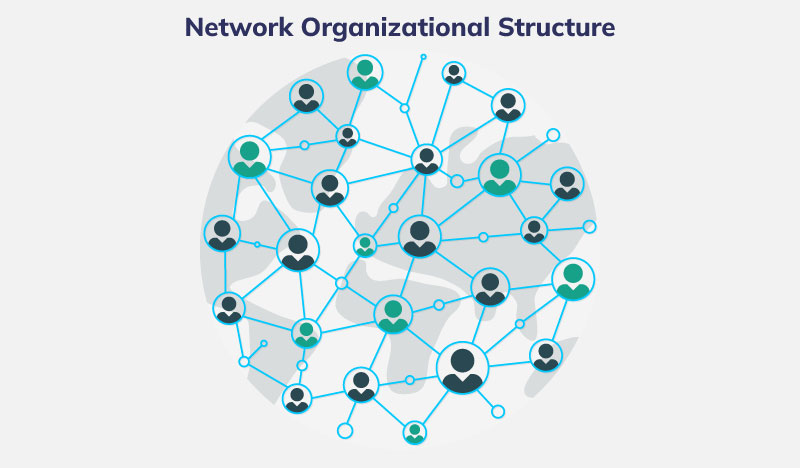Introduction to Network Organizational Structure
Network organizational structure refers to the business structure where the employees form small multidisciplinary teams that work together to achieve various goals. The networks can be created between the internal employees and also with outsourcing partners through strategic alliance. The network organizational structure is opposite to the traditional top to bottom organizational structure as the network organizational structure includes creating groups that specifically handle diverse problems collaboratively without direct supervision.
Moreover, the network organizational structure includes flexible working which helps to cope with various challenges effectively. The network organizational structure aims to promote boundary-less management through participative decision-making. Hence, the network organizational structure can help to promote employee motivation through collaboration and teamwork. One of the key features of the network organizational structure is team collaboration as hundreds of the employees work collaboratively under this structure when the need arises which helps in flexibility and effective completion of diverse tasks.
Table of Contents

The network organizational structure is used by the organizations working in the hybrid organizational structure as companies with the hybrid organizational structure place a higher responsibility on the workgroups. However, we need to consider that the network organizational structure is a temporary arrangement to deal with various complex situations. This way the network organizational structure helps to ensure utilization of the best capabilities and resources in the organization by bringing all the team members collaboratively under the flat and less hierarchical organizational structure.
Advantages of Network Organizational Structure
Network organizational structure is suited for organizations that need constant change and innovation. The key advantages of the network organizational structure are discussed as follows-
Motivated functioning- In the network organizational structure, the operations are managed in the hub which helps to enhance the motivation of the employees in the organization. Moreover, flexible working in the network organizational structure also helps to maintain employee motivation at the workplace.
Streamline operations- The hub-like structure also helps to streamline the business operations by reorganizing the teams to meet diverse challenges which also helps to reduce the cost and increase operational efficiency in the organization.
Cost-effectiveness- Network organizational structure does not involve costs associated with setting up and running various departments by streamlining diverse operations. Moreover, the organization may also outsource the tasks to the other firms in this structure which can further help to reduce the total cost and ensure a better quality of products and services.
Disadvantages of Network Organizational Structure
We have seen that the network organizational structure is important to maintain collaboration during the change management process and deal with complex situations. However, the network organizational structure can result in a lack of clarity regarding the role of each team member. Some of the main disadvantages of the network organizational structure are discussed as follows-
Coordination- Network organizations operate in collaboration with the teams without any definite organizational structure. However, a lack of clarity regarding the work roles can result in coordination problems in the organization. Moreover, each individual may have their own way of working which can result in challenges in coordination in the teams.
Lack of close control- In the network organizational structure, the lack of close control is one of the key issues that can be faced due to the lack of hierarchical organizational structure. This can result in poor control of the employee actions and can also make it difficult to achieve higher performance outcomes.
Conflicting issues- Lack of direct and immediate supervision in the networking organizational structure can also result in conflicting issues within the team if the employees fail to collaborate effectively and have different opinions to deal with the complex problems.
Exemplification of Network Organizational Structure
We have heard about a number of organizations operating through the hierarchical organizational structure. Have you ever heard of any organization that adopts the network organizational structure? The network organizational structure is used by H&M which is a Swedish multinational clothing company to stay competitive, H&M has formed multiple departments especially to target the customer needs. Moreover, H&M has also outsourced its production and processing functions in different countries, majorly in Asian and Southeast Asian countries. Furthermore, the company does not own any of the factories currently and has maintained relationships with around 800 suppliers in Europe and Asia. The production teams of H&M include research and development heads, production managers, inventory managers, marketing executives, etc. who work collaboratively to manufacture products that effectively meet the customer needs. The use of the network organizational structure helps the company to create a collaborative work environment and ensure that all the organizational functions and processes are managed effectively considering the business needs.
In nutshell, it is seen that the organizational structure provides a visual representation of the internal structure and operations of the organization. The type of organizational structure that is used by each organization differs on the basis of the size and operations of the organization. Moreover, we have also found that each organizational structure has its advantages and limitations which need to be taken into consideration while selecting the most suitable organizational structure for the business.
FAQs
In a network structure, employees may have broader and more fluid roles. They are encouraged to collaborate with various nodes and may be part of multiple teams or projects simultaneously. This fosters a sense of empowerment, ownership, and flexibility in how they approach their work.
What role does technology play in supporting a network organizational structure?
Technology plays a vital role in supporting a network organizational structure by providing tools for communication, collaboration, and data sharing among network nodes. Cloud-based platforms, project management software, and virtual meeting tools facilitate seamless interactions and coordination.
Previous Structure
Mechanistic Organizational Structure
 Proof Reading
Proof Reading  Copy Writing
Copy Writing  Resume Writing
Resume Writing  Blogs
Blogs Guides
Guides SOP's
SOP's Student Resources
Student Resources Research Topics
Research Topics Login
Login Register
Register